Top Rankings
Vallejo City Unified School District ranks among the top 20% of public school district in California for:
Category
Attribute
Diversity
Most diverse schools (Top 1%)
Community Size
Largest student body (number of students) (Top 1%)
For the 2025 school year, there is 1 public charter school serving 415 students in Vallejo City Unified School District. This district's average charter testing ranking is 4/10, which is in the bottom 50% of public charter schools in California.
Public Charter School in Vallejo City Unified School District have an average math proficiency score of 24% (versus the California public charter school average of 31%), and reading proficiency score of 32% (versus the 48% statewide average).
Minority enrollment is 91% of the student body (majority Hispanic), which is more than the California public charter school average of 75% (majority Hispanic).
Overview
This School District
This State (CA)
# Schools
20 Schools
1,300 Schools
# Students
9,820 Students
711,386 Students
# Teachers
425 Teachers
31,394 Teachers
Student : Teacher Ratio
23:1
23:1
District Rank
Vallejo City Unified School District, which is ranked #1551 of all 1,925 school districts in California (based off of combined math and reading proficiency testing data) for the 2021-2022 school year.
The school district's graduation rate of 77% has increased from 72% over five school years.
Overall District Rank
#1517 out of 1941 school districts
(Bottom 50%)
(Bottom 50%)

Math Test Scores (% Proficient)
17%
33%

Reading/Language Arts Test Scores (% Proficient)
27%
47%

Science Test Scores (% Proficient)
14%
29%
Graduation Rate
77%
87%
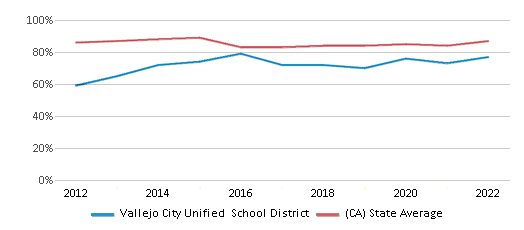
Students by Ethnicity:
Diversity Score
0.66
0.65
# American Indian Students
22 Students
3,137 Students
% American Indian Students
n/a
1%
# Asian Students
1,385 Students
49,250 Students
% Asian Students
14%
7%
# Hispanic Students
5,118 Students
378,755 Students
% Hispanic Students
52%
53%
# Black Students
2,103 Students
48,500 Students
% Black Students
22%
7%
# White Students
530 Students
176,738 Students
% White Students
5%
25%
# Hawaiian Students
163 Students
2,385 Students
% Hawaiian Students
2%
n/a
# Two or more races Students
493 Students
48,230 Students
% of Two or more races Students
5%
7%
Students by Grade:
# Students in PK Grade:
-
83
# Students in K Grade:
943
60,517
# Students in 1st Grade:
804
46,070
# Students in 2nd Grade:
820
47,155
# Students in 3rd Grade:
813
46,520
# Students in 4th Grade:
856
46,583
# Students in 5th Grade:
809
46,919
# Students in 6th Grade:
649
54,274
# Students in 7th Grade:
628
57,837
# Students in 8th Grade:
671
57,970
# Students in 9th Grade:
649
70,272
# Students in 10th Grade:
706
64,790
# Students in 11th Grade:
705
57,670
# Students in 12th Grade:
767
54,726
# Ungraded Students:
-
-
District Revenue and Spending
The revenue/student of $20,247 is higher than the state median of $19,974. The school district revenue/student has grown by 12% over four school years.
The school district's spending/student of $17,143 is less than the state median of $18,396. The school district spending/student has grown by 12% over four school years.
Total Revenue
$199 MM
$116,387 MM
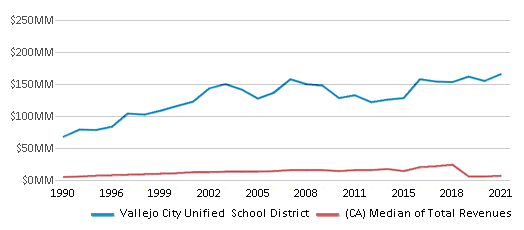
Spending
$168 MM
$107,188 MM
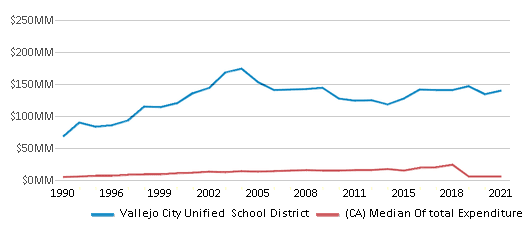
Revenue / Student
$20,247
$19,974
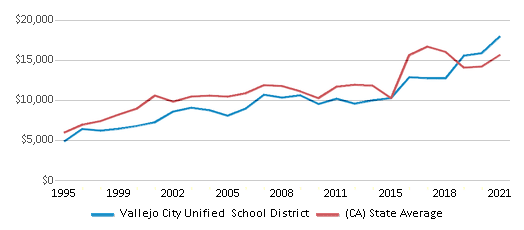
Spending / Student
$17,143
$18,396
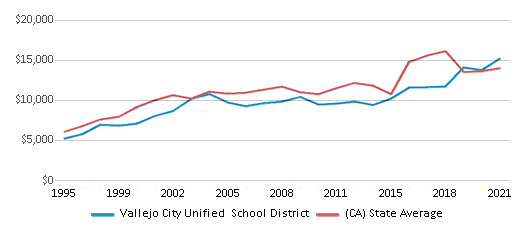
Best Vallejo City Unified School District Public Charter Schools (2025)
School
(Math and Reading Proficiency)
(Math and Reading Proficiency)
Location
Grades
Students
Rank: #11.
Vallejo Charter
Charter School
(Math: 24% | Reading: 32%)
Rank:
Rank:
4/
Bottom 50%10
2833 Tennessee St.
Vallejo, CA 94591
(707) 556-8620
Vallejo, CA 94591
(707) 556-8620
Grades: K-8
| 415 students
Recent Articles

Year-Round Or Traditional Schedule?
Which is more appropriate for your child? A year-round attendance schedule or traditional schedule? We look at the pros and cons.

Why You Should Encourage Your Child to Join a Sports Team
Participating in team sports has a great many benefits for children, there is no doubt. In this article you will learn what those benefits are.

White Students are Now the Minority in U.S. Public Schools
Increasing birth rates among immigrant families from Asia and Central and South America, combined with lower birth rates among white families, means that for the first time in history, public school students in the United States are majority-minority. This shift in demographics poses difficulties for schools as they work to accommodate children of varying language abilities and socio-economic backgrounds.





